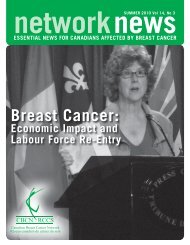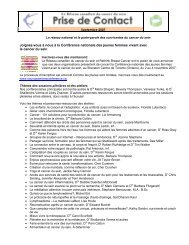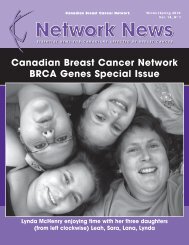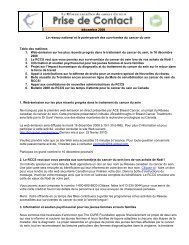to download full presentation (PDF 3Mb)
to download full presentation (PDF 3Mb)
to download full presentation (PDF 3Mb)
Create successful ePaper yourself
Turn your PDF publications into a flip-book with our unique Google optimized e-Paper software.
New Treatment Options for<br />
Metastatic Breast Cancer<br />
A Focus on HER2+ & Triple Negative Disease<br />
Maureen Trudeau, MD, FRCP(C)<br />
Oc<strong>to</strong>ber 29 th , 2010<br />
Sunnybrook Odette Cancer Center<br />
Toron<strong>to</strong>, Canada
1.<br />
2.<br />
3.<br />
Objectives<br />
Discuss the treatment options for HER2+<br />
metastatic breast cancer<br />
Discuss the treatment options for triple<br />
negative (TN) metastatic breast cancer<br />
Discuss recent clinical trial results in HER2+ and<br />
TN metastatic breast cancer
•<br />
•<br />
•<br />
•<br />
•<br />
Case 1: AK<br />
45‐year old woman treated for Hodgkin’s disease at<br />
age 17 with chemo and upper mantle radiation<br />
In 2003 developed right infiltrating duct breast<br />
cancer<br />
ER‐, PR‐, HER2+ disease, 6 nodes +, treated with<br />
ACT after bilateral mastec<strong>to</strong>mies<br />
In 2006 relapsed in bone. Treated with Taxol plus<br />
Herceptin then Herceptin alone for 1 year<br />
At progression in skin enrolled in a phase II study of<br />
Pertuzumab +/‐ Trastuzumab in July 2008
•<br />
•<br />
•<br />
•<br />
•<br />
Case #2: MB<br />
35‐year old female at diagnosis (2006), 2.2cm, grade 3 IDC, LVI ‐, node‐, triple<br />
negative<br />
Treated with adjuvant FEC100 at outside hospital and adjuvant radiation<br />
Winter 2008, recurrent chest colds, persistent cough (6 months after<br />
completing adjuvant tx)<br />
CT scan Chest April 2008 ‐ multiple lung mets (no other mets)<br />
Seen in consultation at SB<br />
–<br />
–<br />
Significant shortness of breath and cough<br />
Treated on ATHENA trial with wkly taxol + AVASTIN (switched <strong>to</strong> Abraxane b/c<br />
of hypersensitivty reaction <strong>to</strong> taxol)
The London Underground<br />
Where <strong>to</strong> start?<br />
A human cancer cell,<br />
pathways visualized by<br />
Gene Network Sciences
The oncology roadmap: A mechanism‐driven (rather<br />
than indication‐driven) approach <strong>to</strong> cancer<br />
I. Bombing the Tumor<br />
Targeting antibody-drug<br />
conjugates <strong>to</strong> tumor antigens<br />
III. Starving the Tumor<br />
Targeting angiogenesis<br />
Signal<br />
transduction<br />
Proteolysis<br />
Metabolism<br />
DNA repair<br />
Cell cycle<br />
II. Choking the Tumor<br />
Targeting pathways for<br />
growth, life, and death<br />
IV. Undermining the Tumor<br />
Halting the regrowth and<br />
spread of cancer cells<br />
V. Rejecting the Tumor<br />
Cancer immunotherapy
All Breast Cancer<br />
ER+<br />
65-75%<br />
HER2+<br />
15-20%<br />
Basaloid<br />
15%
Gene Expression Patterns of Breast<br />
ER<br />
Gene<br />
expression<br />
Basal-like HER2<br />
Subgroup Subgroup<br />
= E = D<br />
Carcinomas Predict Survival<br />
Normal<br />
breast<br />
like<br />
Adapted from Sorlie et al. PNAS, 2001<br />
Luminal<br />
Subtype<br />
C<br />
Luminal<br />
Subtype<br />
B<br />
ER<br />
Gene<br />
expression<br />
Luminal<br />
Subtype<br />
A<br />
O.S.<br />
E<br />
D<br />
months<br />
B<br />
C<br />
A
Herceptin appears <strong>to</strong> change the course of<br />
HER2+ Breast Cancer (NEJM 2006)<br />
• Effect of HER2/neu Amplification and Trastuzumab on the Kaplan–Meier Estimates of Survival Free<br />
of a First Distant Recurrence of Breast Cancer. CI denotes confidence interval.<br />
• Joensuu et al. 354 (8): 809, Figure 3 NEJM, February 23, 2006
Patients, n<br />
In MBC, Trastuzumab increases<br />
survival, but does not provide “cure”<br />
20,000<br />
18,000<br />
16,000<br />
14,000<br />
12,000<br />
10,000<br />
8000<br />
6000<br />
4000<br />
2000<br />
Trastuzumab introduced (adjuvant)<br />
No. of patients prevented from developing metastases<br />
Incidence of HER2+ MBC following without Trastuzumab<br />
introduction of Trastuzumab<br />
27,737<br />
0<br />
2000 2005 2010 2015<br />
Year<br />
MBC, metastatic breast cancer<br />
50-60% 1st line objective response<br />
Most eventually progress on therapy<br />
Weisgerber-Kriegl et al 2008
Anti-signaling<br />
-<br />
-<br />
MOA of Trastuzumab<br />
Inhibition of HER2 shedding.<br />
Inactivation of AKT signaling.<br />
Engagement of Fc<br />
Recep<strong>to</strong>r Binding<br />
- Immune Effec<strong>to</strong>r Function: ADCC.<br />
-FcR<br />
binding and ADCC are not the same.<br />
- Hypercross-linking of Cell Surface Recep<strong>to</strong>rs.<br />
Not necessarily mutually exclusive
Trastuzumab –<br />
There are four<br />
1. Activation of antibody-dependent<br />
cellular cy<strong>to</strong><strong>to</strong>xicity (ADCC)<br />
2. Prevention of formation of<br />
p95 HER2 , a truncated and very<br />
active form of HER2<br />
3. Inhibition of cell proliferation by<br />
preventing HER2-activated<br />
intracellular signalling<br />
4. Inhibition of HER2-regulate<br />
angiogenesis<br />
Mechanism of Action<br />
distinct mechanisms of action:<br />
Trastuzumab<br />
HER2<br />
p95 HER2<br />
HER2<br />
Cleaved<br />
Signalling cell<br />
proliferation<br />
tumor tumor<br />
NK<br />
cell<br />
Release<br />
substances<br />
Metalloproteinase<br />
HER2<br />
Angiogenesis<br />
Tumor Cell Death<br />
Trastuzumab<br />
HER2<br />
No signalling<br />
tumor<br />
Trastuzumab<br />
Decreased<br />
blood<br />
supply<br />
Nahta et al. Breast Cancer Res 2006; Clynes et al. Nat Med 2000; Gennari et al. Clin Cancer Res 2004; Arnould et al. Br J Cancer 2006; Molina et al. Cancer Res 2001; Fry et al. Breast Cancer<br />
Res 2001; Gershtein et al. Clin Chim Acta 1999; Yakes et al. Cancer Res 2002;Longva et al. Int J Cancer 2005; Izumi et al. Nature 2002; Nahta et al. Breast Cancer Res 2006; Wen et al.<br />
Oncogene 2006
Trastuzumab and Pertuzumab: Distinct<br />
Epi<strong>to</strong>pes on HER2 Extracellular Domain<br />
I I<br />
III<br />
IV<br />
II<br />
• Potent inhibi<strong>to</strong>r of HER2-mediated<br />
signaling pathways<br />
• Activates antibody-dependent<br />
cellular cy<strong>to</strong><strong>to</strong>xicity<br />
• Inhibits shedding and, thus,<br />
formation of p95<br />
II<br />
III<br />
Trastuzumab Pertuzumab<br />
IV<br />
Prevents recep<strong>to</strong>r dimerization<br />
Potent inhibi<strong>to</strong>r of HER-mediated signaling<br />
pathways
Pertuzumab: Phase II Results<br />
•<br />
•<br />
•<br />
Novel HER2‐targeted monoclonal antibody<br />
Phase II study of pertuzumab/trastuzumab<br />
–<br />
–<br />
–<br />
HER2+ MBC; progression on prior trastuzumab<br />
ORR = 24%<br />
No significant cardiac events observed<br />
Pertuzumab +/‐ trastuzumab after progression on<br />
prior HER2‐targeted therapy<br />
Efficacy Endpoint<br />
Pertuzumab<br />
(n = 29)<br />
Pertuzumab/<br />
Trastuzumab<br />
(n = 14)<br />
ORR 1 (3%) 3 (21%)<br />
CBR 3 (10%) 6 (43%)<br />
Combination active in pts with<br />
progression on prior<br />
trastuzumab and pertuzumab<br />
Baselga et al., J Clin Oncol 2010; 28: 1138‐44.<br />
Baselga et al. SABCS 2009; abstract 5114.
Phase III Cleopatra Trial ‐<br />
Eligibility Eligibility criteria:<br />
criteria:<br />
• • HER2+<br />
HER2+<br />
• • Locally Locally recurrent<br />
recurrent<br />
or or MBC<br />
MBC<br />
• • No No prior<br />
prior<br />
chemotherapy chemotherapy or<br />
or<br />
targeted targeted therapy<br />
therapy<br />
for for metastatic<br />
metastatic<br />
disease<br />
disease<br />
• • = = 1 1 prior prior hormonal<br />
hormonal<br />
therapy therapy for<br />
for<br />
metastatic metastatic disease<br />
disease<br />
• • =12 =12 month month diseasediseasefreefree<br />
interval interval since<br />
since<br />
completion completion of<br />
of<br />
systemic systemic therapy<br />
therapy<br />
R<br />
a<br />
n<br />
d<br />
o<br />
m<br />
i<br />
z<br />
e<br />
Accrual goal = 800<br />
Ongoing<br />
Trastuzumab 8mg/kg loading,<br />
then 6mg/kg q3w<br />
+ Docetaxel 75 mg/m2 Trastuzumab 8mg/kg loading,<br />
then 6mg/kg q3w<br />
+ Docetaxel 75 mg/m q3w<br />
+ Placebo<br />
2 q3w<br />
+ Placebo<br />
Trastuzumab 8mg/kg loading,<br />
then 6mg/kg q3w<br />
+ Docetaxel 75 mg/m2 Trastuzumab 8mg/kg loading,<br />
then 6mg/kg q3w<br />
+ Docetaxel 75 mg/m q3w<br />
+ Pertuzumab 840mg (cycle1),<br />
then 420mg q3w<br />
2 q3w<br />
+ Pertuzumab 840mg (cycle1),<br />
then 420mg q3w<br />
1° endpoint: PFS by<br />
independent review
•<br />
•<br />
•<br />
•<br />
Case again…<br />
Response in skin nodule on Pertuzumab<br />
Developed brain mets in March 2009 and<br />
Trastuzumab added back plus brain radiation<br />
After 6 months presented with confusion, slowed<br />
mo<strong>to</strong>r and mental functions. CT changes called<br />
central pontine myelinolysis (CMP). Treatment<br />
s<strong>to</strong>pped<br />
At progression in liver in June 2010 enrolled in<br />
clinical trial of TDM‐1 vs. Capecitabine + Lapatinib
Phase III Randomized Trial of Capecitabine/Lapatinib<br />
vs. Trastuzumab MCC‐DM1 in HER2‐Postive MBC<br />
Previously Treated with Trastuzumab<br />
Randomize<br />
T-DM1 3.6mg/kg IV Day 1<br />
Capecitabine 1000mg/m 2 PO bid, Days 1-14<br />
Lapatinib 1250mg PO daily<br />
Both regimens repeated q 21 days
Novel Cy<strong>to</strong><strong>to</strong>xics: Antibody Drug Conjugates<br />
Trastuzumab‐MCC‐DM1 (T‐DM1)<br />
• Binds <strong>to</strong> HER2 with affinity similar <strong>to</strong><br />
trastuzumab<br />
• Provides intracellular delivery of mertansine<br />
• Derivative of maytansine, a natural-product microtubule<br />
polymerization inhibi<strong>to</strong>r<br />
• 20-100 more potent than vincristine
T-DM1 Selectively Delivers a Highly Toxic<br />
Payload <strong>to</strong> HER2-Positive Tumor Cells<br />
UNIQUE<br />
DUAL MoAb<br />
•<br />
•<br />
Recep<strong>to</strong>r-T-DM1 complex is<br />
internalized in<strong>to</strong> HER2-<br />
positive cancer cell<br />
Baselga J, et al. Nat Rev Cancer. 2009;9:463-475.<br />
Trastuzumab-like activity by binding <strong>to</strong> HER2<br />
Targeted intracellular delivery T-DM1 binds of <strong>to</strong> a the potent HER2<br />
protein on cancer cells<br />
antimicrotubule agent, DM1<br />
Potent antimicrotubule<br />
agent is released once<br />
inside the HER2-positive<br />
tumor cell
Phase II Study: TDM4374g<br />
• Single-agent T-DM1, a novel HER2 directed ADC, demonstrated<br />
robust antitumor activity in a predefined population that had a<br />
median time from metastatic diagnosis of >3 years and received<br />
>2 years of prior HER2-directed therapy:<br />
– ORR: 32.7% IRF, 30% INV<br />
–CBR: 44.5% IRF, 40% INV<br />
• This robust level of activity was seen in an advanced patient<br />
population not previously studied:<br />
– Required prior treatment included an anthracycline, a taxane,<br />
capecitabine, trastuzumab, and lapatinib<br />
– Received 2 HER2-directed regimens in the metastatic setting<br />
– Progressive disease on last regimen received
T‐DM1 Clinical Trials for HER2+ MBC Patients<br />
• Phase I<br />
– N=52, with 2 schedules of single agent T-DM1<br />
• Ph II (pivotal)<br />
– T-DM1 in patients who progressed on HER2 therapy<br />
• Randomized Ph II study in the front-line setting*<br />
– N=120, T-DM1 vs trastuzumab + docetaxel<br />
• Randomized Phase III<br />
– N=580, T-DM1 vs lapatinib + capecitabine<br />
• Explora<strong>to</strong>ry combination trials<br />
– T-DM1 + pertuzumab, T-DM1 + taxanes<br />
Stuart Lutzker, Scott Holden, Barb Klencke
•<br />
•<br />
•<br />
Case again…<br />
Response in liver, skin, nodes on TDM‐1 on<br />
study<br />
Response ongoing<br />
Hemorrhage in<strong>to</strong> eyes secondary <strong>to</strong> diabetic<br />
retinopathy treated with intraocular<br />
Bevacizumab
Phase III Trials of Continued HER2‐Targeted Therapy in<br />
MBC Previously Treated with Trastuzumab<br />
TBPTriala TBPTrial EGF100151 Trial<br />
a EGF100151 Trial<br />
Capecitabine/<br />
Trastuzumab<br />
(n = 75)<br />
Capecitabine<br />
(n = 68)<br />
Capecitabine/<br />
Lapatinib<br />
(n = 198)<br />
Capecitabine<br />
(n = 201)<br />
Overall Response Rate<br />
37 (48%) 20 (27%)<br />
OR 2.50; P = .0115<br />
24% 14%<br />
OR 1.9; P = .017<br />
Clinical Benefit Rate b Capecitabine/<br />
Trastuzumab<br />
(n = 75)<br />
Capecitabine<br />
(n = 68)<br />
Capecitabine/<br />
Lapatinib<br />
(n = 198)<br />
Capecitabine<br />
(n = 201)<br />
Overall Response Rate<br />
37 (48%) 20 (27%)<br />
OR 2.50; P = .0115<br />
24% 14%<br />
OR 1.9; P = .017<br />
Clinical Benefit Rate<br />
58 (75%) 40 (54%)<br />
OR 2.59; P = .0068<br />
29% 17%<br />
OR 2.0; P = .008<br />
b 58 (75%) 40 (54%)<br />
OR 2.59; P = .0068<br />
29% 17%<br />
OR 2.0; P = .008<br />
Median Time <strong>to</strong><br />
Progression<br />
Median Overall Survival<br />
8.2 months 5.6 months 6.2 months 4.3 months<br />
HR 0.69; P = .0338 HR 0.57; P < .001<br />
25.5 months 20.4 months 15.6 months 15.3 months<br />
HR 0.76; P = .2570 HR 0.78; P = .177<br />
a German Breast Group 26/Breast International Group 03-05 trial<br />
b CR + PR + SD > 24 weeks for TBP trial; CR + PR + SD ≥ 6 months for EGF100151 trial.<br />
von Minckwitz et al. J Clin Oncol 2009; 27:1999‐2006.<br />
Cameron et al. Oncologist Aug 2010 (epub ahead of print).
Lapatinib + Capecitabine vs. Capecitabine<br />
Cameron, Casey, Olivia, et al., The Oncologist 2010
Lapatinib + Capecitabine vs. Capecitabine<br />
Cameron, Casey, Olivia, et al., The Oncologist 2010
Lapatinib Studies in Patients with CNS Metastases<br />
•<br />
•<br />
•<br />
Phase III trial of lapatinib/capecitabine (n = 198) vs.<br />
capecitabine alone (n = 201) in MBC:<br />
– Explora<strong>to</strong>ry analysis of the brain as site of first<br />
progression: 2% vs. 6%; P = .045<br />
Small phase II trial of recurrent CNS metastases (n = 39):<br />
– 2.6% PR; 18% progression free at 16 weeks<br />
Phase II trial of recurrent CNS metastases:<br />
Geyer et al. J Clin Oncol 2007 26(suppl):40s (abstract 1035).<br />
Lin et al. J Clin Oncol 2008; 26:1993‐9.<br />
Lin et al. Cancer Therapy Res 2009; 15:1452‐9.
Clinical Trials of Neratinib in Patients Previously<br />
Treated with HER2‐Targeted Agents<br />
a<br />
b<br />
Intent-<strong>to</strong>-treat population<br />
ORR for patients who have received prior lapatinib or trastuzumab<br />
Burstein et al. J Clin Oncol; February 8, 2010 [e‐pub ahead of print].<br />
Swaby et al. J Clin Oncol 2009; 27(suppl):42s (abstract 1004).<br />
Chow et al. Cancer Res 2009; 69(suppl):792s (abstract 5081).
Trastuzumab disrupts ligand‐independent<br />
HER2‐HER3‐PI3K complex<br />
The oncogenic unit in HER2+ve breast cancer is a<br />
complex between HER2-HER3<br />
Junttila et al. Cancer Cell, 2009.
O<br />
PI3 Kinase Inhibi<strong>to</strong>r: GDC‐0941<br />
S O S O<br />
N<br />
N<br />
Class 1A PI3K<br />
Pan inhibi<strong>to</strong>r<br />
S<br />
O<br />
N<br />
N<br />
N<br />
N<br />
NH<br />
Inhibition of PI3K by GDC-0941<br />
Enzyme IC 50<br />
Class 1A:<br />
p110 alpha 3 nM<br />
p110 alpha E545K 3 nM<br />
p110 alpha H1047R 3 nM<br />
p110 beta 33 nM<br />
p110 delta 3 nM<br />
Class 1B:<br />
p110 gamma 75 nM<br />
PIK Family, (>200 fold selectivity)<br />
Class II: CIIbeta 0.670 uM<br />
Class III: VPS34 >10 uM<br />
Class IV: DNA-PK 1.230 uM<br />
Class IV: mTOR (Ki) 0.580 uM<br />
Protein Kinase panel<br />
>300 fold selectivity against 228 kinase panel<br />
Folkes et al. 2008 J Med Chem.
GDC‐0941 Overcomes Trastuzumab Resistance<br />
Junttila et al. Cancer Cell, 2009.
The “Triple Negative”<br />
Cancer<br />
“Basal-Like”<br />
Breast<br />
Estrogen Recep<strong>to</strong>r (ER) negative<br />
Progesterone recep<strong>to</strong>r (PR) negative<br />
Her2neu (HER2) negative<br />
ER/PR/HER2 -
•<br />
•<br />
•<br />
“Triple Negative”<br />
Breast Cancers<br />
Comprise approximately 15% of all invasive<br />
cancers<br />
More common in:<br />
–<br />
–<br />
–<br />
Younger patients<br />
African Americans (up <strong>to</strong> 60% premenopausal women in Africa)<br />
BRCA1 mutation carriers ( up <strong>to</strong> 80%)<br />
Unique Morphologic Attributes<br />
– Pushing border<br />
– high grade<br />
– central scarring/acellular zone<br />
– Stromal/peritumoral lymphocytic infiltrate
•<br />
•<br />
•<br />
•<br />
•<br />
•<br />
•<br />
•<br />
•<br />
Triple-Negative Tumors are<br />
IDC NOS, high grade<br />
ILC high grade, pleomorphic<br />
Metaplastic, high grade<br />
Myoepithelial carcinoma<br />
Heterogeneous<br />
High grade (oat-cell) neuroendocrine<br />
Apocrine<br />
Medullary<br />
Adenoid-cystic<br />
Metaplastic, low grade<br />
–<br />
–<br />
low grade adenosquamous<br />
fibroma<strong>to</strong>sis-like<br />
Poor<br />
prognosis<br />
Good prognosis
Hazard Rate<br />
0.35<br />
0.30<br />
0.25<br />
0.20<br />
0.15<br />
0.10<br />
0.05<br />
0.00<br />
Hazard Rate of Distant Recurrence<br />
Other (290 of 1421) “Triple-negative”<br />
0 1 2 3 4 5 6 7 8 9 10<br />
Years after first surgery<br />
(61 of 180)<br />
Median Time <strong>to</strong> Distant Recurrence<br />
TN Breast Ca = 2.6 yrs<br />
Dent R, Trudeau M, Pritchard K, Hana W, Narod S. et al. Clinical Cancer Res 2007<br />
Other Breast Ca = 5 yrs p < 0.0001
Median Time from Distant Relapse <strong>to</strong><br />
“Triple Negative”<br />
Breast CA<br />
Other Breast CA<br />
9 months<br />
Death<br />
22 months<br />
0 5 10 15 20 25<br />
Dent R, Trudeau M, Pritchard K, Hana W, Narod S. et al. Clinical Cancer Res 2007
Poor Outcome of Metastatic TNBC (N = 112)<br />
Initial<br />
therapy<br />
F. Kassam, #1121<br />
F. Heitz, #1010<br />
Median D.F.I.<br />
First distant<br />
relapse<br />
First<br />
Line<br />
CT<br />
12 weeks<br />
Second<br />
Line<br />
CT<br />
9 weeks<br />
Is RECIST adequate ?<br />
Third<br />
Line<br />
CT<br />
4 wks<br />
Higher risk for developing brain mets OR : 4.16<br />
(95% CI 2.26 – 7.64)<br />
Median O.S. = 3.0 months
Patterns of Metastatic Spread<br />
Non-productive<br />
dry cough<br />
But...Bone Marrow<br />
infiltration
•<br />
•<br />
•<br />
What is “Standard Therapy”<br />
Negative Breast Cancer?<br />
for Triple<br />
No specific systemic regimen guidelines exist<br />
Little data in which <strong>to</strong> base decisions<br />
Few his<strong>to</strong>rical controls making it challenging<br />
<strong>to</strong> design clinical trials for this subgroup
Chemosensitive early TNBC<br />
has a favourable Outcome
Taxanes for Metastatic TNBC?<br />
Trial Phase N Setting Taxane Outcome in TNBC<br />
Harris et<br />
al.<br />
CALGB<br />
9342<br />
ECOG<br />
2100<br />
III 44 1 st / 2 nd<br />
line<br />
Metastatic<br />
III 10<br />
9<br />
1 st line<br />
Metastatic<br />
AVADO III 52 1 st line<br />
Metastatic<br />
Paclitaxel<br />
Weekly and<br />
q3wk<br />
Paclitaxel<br />
Weekly<br />
Docetaxel<br />
q3wk<br />
ORR = 26%<br />
TTF= 2.8 months<br />
OS = 8.6 months<br />
ORR = 11.7%<br />
PFS = 5.3 months<br />
ORR = 23.1%<br />
PFS = 8.2 months
Angiogenic Switch and VEGF<br />
Small tumour (1–2mm)<br />
• Avascular<br />
• Dormant<br />
Angiogenic<br />
switch<br />
Adapted from Bergers G, et al. Nature 2002;3:401–10<br />
dependency<br />
Larger tumour<br />
• Vascular<br />
• Metastatic potential<br />
Over-expression of pro-angiogenic signals, such as VEGF
Trial / Arm<br />
E2100<br />
Bevacizumab for TNBC<br />
Median PFS (mo) in TNBC<br />
Subset<br />
Paclitaxel (n=110) 5.3<br />
Paclitaxel + bevacizumab (n=122) 10.6<br />
AVADO<br />
Docetaxel + placebo (n=52) 5.4<br />
Docetaxel + bevacizumab 15 mg/kg (n=58) 8.2<br />
RIBBON-1<br />
Taxane/anthracycline + placebo (n=46) 6.2<br />
Taxane/anthracycline + bevacizumab (n=96) 6.5<br />
Capecitabine + placebo (n=50) 4.2<br />
Capecitabine + bevacizumab (n=87) 6.1<br />
ATHENA<br />
Taxane-based regimen + bevacizumab (n=577) 7.2*<br />
*Median PFS vs non-TNBC subgroup.<br />
No survival data in TNBC
RIBBON-1 2<br />
E2100 1 AVADO 2 Capecitabine Taxane/anthracycline<br />
Median, months Median, months Median, months Median, months<br />
Pac Bev<br />
+ pac<br />
Pla<br />
+ doc<br />
Bev<br />
+ doc<br />
Pla<br />
+ cap<br />
Bev<br />
+ cap<br />
Pla<br />
+ t/a<br />
Overall* n=722 n=488 n=615 n=622<br />
Triple-<br />
negative ‡<br />
Bevacizumab Delivers a Consistent PFS<br />
*Stratified analyses<br />
‡ Unstratified analyses<br />
Benefit in Patients With<br />
Triple‐Negative Disease<br />
Bev<br />
+ t/a<br />
5.8 11.3 8.1 10.0 5.7 8.6 8.0 9.2<br />
HR=0.48 HR=0.67 HR=0.69 HR=0.64<br />
n=232 n=111 n=137 n=142<br />
5.3 10.6 6.1 8.1 4.2 6.1 6.2 6.5<br />
HR=0.49 HR=0.68 HR=0.72 HR=0.78<br />
1. O’Shaughnessy, et al. SABCS 2009; 2. Glaspy, et al. EBCC 2010
•<br />
•<br />
•<br />
Case #2: MB<br />
Treated from April 2008 <strong>to</strong> September 2008 with excellent clinical<br />
and radiological response<br />
Oc<strong>to</strong>ber 2008 presented with new headaches, MRI shows diffuse<br />
brain and lep<strong>to</strong>meningeal disease<br />
– Treated with WBR with good response<br />
Treated with Cisplatin and Gemcitabine x 8 months with good<br />
clinical and radiologic response
TNBC Shares Clinical and Pathologic Features with<br />
BRCA‐1‐Related Breast Cancers<br />
Characteristics Hereditary BRCA1 Triple Negative/Basal-Like 1,2,3<br />
ER/PR/HER2 status Negative Negative<br />
TP53 status Mutant Mutant<br />
BRCA1 status Mutational inactivation* Diminished expression*<br />
Gene-expression pattern Basal-like Basal-like<br />
Tumor his<strong>to</strong>logy<br />
Chemosensitivity <strong>to</strong> DNA-<br />
damaging agents<br />
Poorly differentiated<br />
(high grade)<br />
Poorly differentiated<br />
(high grade)<br />
Highly sensitive Highly sensitive<br />
*BRCA1 dysfunction due <strong>to</strong> germline mutations, promoter methylation, or overexpression of HMG or ID4 4<br />
1 Perou et al. Nature. 2000; 406:747-752<br />
3Sorlie et al. Proc Natl Acad Sci U S A 2001;98:10869-74<br />
4 Miyoshi et al. Int J Clin Oncol 2008;13:395-400<br />
2 Clea<strong>to</strong>r et al.Lancet Oncol 2007;8:235-44 4
Platinum for Neoadjuvant Therapy in<br />
BRCA1 Mutation Carriers in Poland<br />
Gronwald et al. ASCO 2009<br />
BRCA1<br />
Mutation<br />
Carriers with<br />
Tumors >2cm<br />
•N = 25<br />
•median age: 46<br />
.<br />
CISPLATIN<br />
75mg/m2<br />
q 3wks IV x 12 wks<br />
•28% with clinically positive lymph nodes<br />
•22 pts completed 4 cycles of Cisplatin,<br />
3 patients completed 2 cycles<br />
Results<br />
Clinical and<br />
Pathological<br />
Response<br />
Complete PR = 72%
Trial Phase /<br />
No. of<br />
TNBC<br />
pts<br />
Platinum Agents for TNBC<br />
Setting Regimen Outcome in TNBC<br />
Gronwald II (N =25) Neoadjuvant Cisplatin pCR = 72%<br />
Sikov<br />
(2009)<br />
Torrisi<br />
(2008)<br />
Silver<br />
(2010)<br />
Uhm<br />
(2009)<br />
II (n=12) Neoadjuvant Carbo-P vs<br />
carbo-P-H<br />
II (n=30) Neoadjuvant<br />
TNBC<br />
II (n=28) Neoadjuvant<br />
TNBC<br />
II (n=36) Metastatic Carbo-P or<br />
Cis-P<br />
pCR=67%<br />
E-Cis-FP pCR=40%; ORR=86%<br />
Cis pCR=22%<br />
ORR 37.5%
Reference Regimen n Prior Rx RR TTP OS<br />
Nagourney JCO<br />
2000<br />
Burch Am J<br />
Oncol 2005<br />
Fuentes<br />
Anticancer<br />
Drugs 2006<br />
Heinemann<br />
Cancer Chemo<br />
Pharmacol 2006<br />
Seo Cancer<br />
Chemo<br />
Pharmacol 2007<br />
Tas Invest New<br />
Drugs 2008<br />
Kim Cancer Res<br />
Treat 2008<br />
Gem 1 g/m2 D1,8,15<br />
Cis 30 mg/m2 D1,8,15<br />
Gem 1g/m2 D1,8,15<br />
Cis 25 mg/m2 D1,8,15<br />
Gem 1.2g/m2 D1,8<br />
Cis 75 mg/m2 D1<br />
Gem 750 mg/m2 D1,8,<br />
Cis 30 mg/m2 D1,8<br />
Gem 1250 mg/m2 D1,<br />
8<br />
Cis 75 mg/m2 D1<br />
Gem 2 g/m2 D1,8<br />
Cis 50 mg/m2 D1,8<br />
Gem 1 g/m2 D1,8<br />
Cis 60 mg/m2<br />
Chew JCO 2009 Gem 1 g/m2 D2,8<br />
Cis 25 mg/m2 D1‐4<br />
Somali<br />
Chemotherapy<br />
2009<br />
Gem 1 g/m2 D1, 8<br />
Cis 30 mg/m2<br />
30 ++ 50% 14 weeks<br />
58 Anthra and<br />
taxane<br />
29%,<br />
then<br />
32%;<br />
31 and 26<br />
weeks<br />
68 and 54<br />
weeks<br />
42 No 81% 15 months 28<br />
months<br />
38 Prior anthra,<br />
taxane<br />
40% 6 months 14<br />
months<br />
30 Prior taxane 30% 7 months 15<br />
months<br />
27 Prior anthra,<br />
taxane<br />
38 Prior anthra<br />
or taxane<br />
26% 7 months<br />
29% 5 months 20<br />
months<br />
136 74 ++ treated 26% 11 and 13<br />
months<br />
31 Prior anthra<br />
and taxane<br />
26% 4 months 10<br />
months
•<br />
•<br />
PARP inhibi<strong>to</strong>rs (PARPi)<br />
Single‐stranded breaks are usually repaired by the<br />
base excision repair pathway, of which PARP1 is one<br />
of the central components<br />
In the absence of this pathway, single stranded<br />
breaks degenerate <strong>to</strong> double stranded breaks, which<br />
are not repaired by BRCA null cells<br />
–<br />
In vitro data has shown that inhibition of PARP1 leads <strong>to</strong><br />
highly selective apop<strong>to</strong>sis of BRCA1 null cells
•<br />
•<br />
•<br />
•<br />
•<br />
Poly(ADP‐ribose) polymerase (PARP)<br />
A key regula<strong>to</strong>r of DNA damage repair processes<br />
Involved in DNA base‐excision repair (BER)<br />
Binds directly <strong>to</strong> DNA damage<br />
Produces large branched chains of poly (ADP‐ribose)<br />
Attracts and assists BER repair effec<strong>to</strong>rs<br />
XRCC1<br />
PNK<br />
Polß<br />
Lig3
ITT cohort<br />
Phase II Trial of Olaparib: Efficacy<br />
400 mg BID<br />
N = 27<br />
100 mg BID<br />
N = 27<br />
ORR 11 (41%) 6 (22%)<br />
CR 1 (4%) 0<br />
PR 10 (37%) 6 (22%)<br />
Median<br />
PFS<br />
5.7 mo<br />
(4.6‐7.4)<br />
3.8 mo<br />
(1.9 –5.6)<br />
Best percent change from baseline<br />
in target lesions by genotype<br />
Tutt A et al. J Clin Oncol 2009; 27(18S):803s (abstr CRA501)
Phase II Trial of Iniparib in TNBC:<br />
• Multicenter<br />
• Open‐label<br />
Gemcitabine (1000 mg/m 2 , IV, d 1, 8)<br />
Carboplatin (AUC 2, IV, d 1, 8)<br />
Study Design<br />
Metastatic TNBC<br />
N = 120<br />
RANDOMIZE<br />
1:1<br />
RESTAGING<br />
Every 2 Cycles<br />
* Patients randomized <strong>to</strong> gem/carbo alone could crossover <strong>to</strong><br />
receive gem/carbo + iniparib at disease progression<br />
Iniparib (5.6 mg/kg, IV, d 1, 4, 8, 11)<br />
Gemcitabine (1000 mg/m 2 , IV, d 1, 8)<br />
Carboplatin (AUC 2, IV, d 1, 8)
Phase II Trial of Iniparib: PFS<br />
(Data through March 09<br />
Iniparib + Gem/Carbo (n = 57)<br />
Median PFS = 6.9 months<br />
Gem/Carbo (n = 59)<br />
Median PFS = 3.3 months<br />
P < 0.0001<br />
HR = 0.342 (95% CI, 0.200-0.584)
OS, %<br />
Phase II Trial of Iniparib:<br />
Overall Survival, ITT<br />
(Data through November 2009<br />
Months<br />
Iniparib/Gem/Carbo: median = 12.2 months<br />
Gem/Carbo: median = 7.7 months<br />
O'Shaughnessy J et al. SABCS 2009. Abstract 3122.
Phase II Study of Olaparib in Advanced Serous Ovarian<br />
Cancer and Triple‐Negative Breast Cancer<br />
Efficacy<br />
ORR in Planned Cohorts<br />
Ovarian<br />
(n = 64)<br />
Breast<br />
(n = 26)<br />
BRCA 4/10 (40%) 0/9 (0)<br />
Unknown BRCA 14/53 (26%) 0/14 (0)<br />
ORR by Actual BRCA Status<br />
Mutant BRCA 7/17 (41%) 0/8 (0)<br />
Non-BRCA 11/46 (24%) 0/15 (0)<br />
Median PFS 219 days 54 days<br />
Gelmon et al., J Clin Oncol 2010; 28(suppl):233s (abstract 3002).
Phase I/II Study of Olaparib Plus Paclitaxel for<br />
Triple‐Negative Metastatic Breast Cancer<br />
• Dose modifications:<br />
Cohort 1 (No G-CSF)<br />
(n = 9)<br />
- Cohort 1: paclitaxel modified in 89%; olaparib modified in 44%<br />
- Cohort 2: paclitaxel modified in 60%; olaparib modified in 30%<br />
• Conclusions:<br />
- Olaparib/paclitaxel is active in triple-negative MBC.<br />
- Associated neutropenia reduced paclitaxel dose intensity<br />
Cohort 2 (G-CSF )<br />
(n = 10)<br />
Overall Response Rate 33% 40%<br />
Stable Disease = 7 Weeks 33% 40%<br />
Median Progression-Free<br />
Survival (95% CI)<br />
6.3 (3.5-8.9) months 5.2 (3.5-NC) months<br />
Eligibility: = 1 prior cy<strong>to</strong><strong>to</strong>xic regimen<br />
Regimen: olaparib 200 mg p.o., b.i.d.<br />
paclitaxel 90 mg/m 2 /week 3 of 4 weeks
Phase II Study of Veliparib Plus Temozolomide in<br />
Metastatic Breast Cancer: Efficacy<br />
Overall Response<br />
Rate<br />
Total<br />
(n = 41)<br />
(23 TNBC)<br />
BRCA1/2 Mutant<br />
(n = 8)<br />
BRCA1/2<br />
Normal/Unknown<br />
(n = 33)<br />
7% 37.5% 0<br />
Clinical Benefit Ratea Clinical Benefit Rate 17% 62.5% 6%<br />
a 17% 62.5% 6%<br />
Median Progression-<br />
Free Survival<br />
a ORR + stable disease<br />
1.9 months<br />
5.5 months 1.8 months<br />
P = .0042<br />
• Efficacy appears <strong>to</strong> be restricted <strong>to</strong> BRCA1/2 mutation carriers.<br />
• Further evaluation of this combination is ongoing in BRCA1/2mutated<br />
cancers.<br />
Isakoff et al. J Clin Oncol 2010; 28(suppl):118s (abstract 1019).
Development of PARP inhibi<strong>to</strong>rs in<br />
Triple-negative breast cancer<br />
Defining triple-negative breast<br />
cancers<br />
Identifying subset with homologous<br />
recombination deficiency<br />
What are standards of care for<br />
treatment?<br />
What should compara<strong>to</strong>rs be?<br />
TNBC<br />
Challenges<br />
Dosing: iv vs po<br />
PARP inhibi<strong>to</strong>rs<br />
Schedule: Intermittent vs<br />
continuous<br />
Timing: Delivery before, during or<br />
after chemotherapy<br />
Are they best combined with DNA<br />
damaging agent?
Capecitabine for Metastatic TNBC?<br />
Trial Phase N Setting Treatment Outcome in TNBC<br />
Rugo et al.<br />
SABCS 2008<br />
III 208 3 rd line or<br />
greater<br />
Metastatic<br />
Pooled<br />
Analysis<br />
RIBBON 1 III 50 1 st line<br />
Metastatic<br />
Capecitabine<br />
vs. Cape +<br />
Ixabepilone<br />
Cape vs. Cape + Ixap<br />
ORR = 15 vs. 31%<br />
PFS = 1.7 vs. 4.2 mo<br />
Capecitabine ORR = 4.2 months
Other Targets for TNBC<br />
Target Agent/Approach<br />
DNA repair pathways<br />
PARP inhibi<strong>to</strong>rs (BSI-201, olaparib, AG014699,<br />
ABT-888), trabectedin<br />
VEGFR-VEGF Bevacizumab, Sorafenib, IMC113<br />
EGFR Erlotinib, Gefinitib, Cetuximab, Panitumumab<br />
Angiogenesis Endo TAG-1, metronomic chemotherapy<br />
Src kinase Dasatinib<br />
Checkpoint kinase 1 UCN-01<br />
mTOR RAD001, everolimus, temsirolimus<br />
Androgen recep<strong>to</strong>r Bicalutamide<br />
TRAIL Lexatumumab<br />
TGF-beta GC1008, AP 12009, LY2157299<br />
Androgen recep<strong>to</strong>r Bicalutamide<br />
Adapted from Tan and Swain. Cancer Journal. 2008;14.
•<br />
•<br />
•<br />
Treatment Summary for TNBC<br />
No standard therapy for metastatic TNBC<br />
–<br />
No evidence that one chemotherapy is superior <strong>to</strong><br />
another<br />
Most active agents currently licensed for use<br />
appear <strong>to</strong> be:<br />
–<br />
–<br />
Chemotherapy + Bevacizumab<br />
Cisplatin based chemotherapy<br />
Promising agents likely <strong>to</strong> be licensed:<br />
– PARP inhibi<strong>to</strong>rs














